Is Torosaurus a Valid Genus? Canadian Fossils Suggest it is
Palaeontologists have debated the validity of the Torosaurus genus for decades. Some scientists see this large chasmosaurine known from the Upper Cretaceous (Maastrichtian faunal stage) as a distinct taxon, whilst others consider the genus to be invalid, the fossil material representing old and mature examples of Triceratops.
Analysis of horned dinosaur fossil material from Canada lends support to the idea that Torosaurus is distinct from Triceratops and that it is a valid taxon. A microscopic study of bone composition indicates that the individual animal represented was still growing at the time of its death. This evidence challenges the idea that fossils attributed to Torosaurus are just the remains of very old, fully grown and very mature Triceratops.
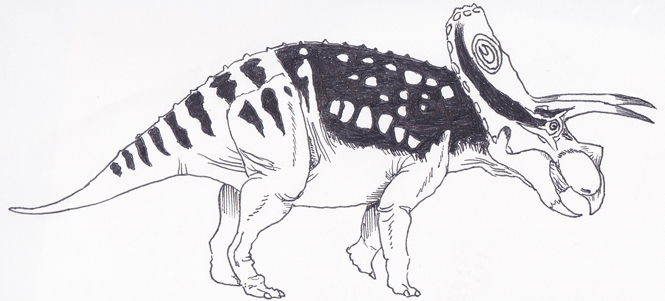
An illustration of the Late Cretaceous chasmosaurine Torosaurus latus. Some palaeontologists have proposed that Torosaurus is simply a skeletally mature growth form of the contemporaneous Triceratops. New research studying partial ceratopsian frills and limb bones found in Canada suggests that Torosaurus is a valid taxon. Picture credit: Everything Dinosaur.
Picture credit: Everything Dinosaur
Canadian Fossils Indicate that Torosaurus is a Valid Taxon
Writing in the Zoological Journal of the Linnean Society, researchers from the Canadian Museum of Nature, the Royal Saskatchewan Museum and Fibics Incorporated (Ontario), analysed two partial cranial frills attributed to Torosaurus. The first, EM P16.1 comes from Frenchman Formation exposures in Saskatchewan which represent uppermost Maastrichtian deposits. This fossil material was collected in 1947 along with two fragmentary thigh bones that were later damaged by floodwater when in storage, the limb bones provided the material for the osteohistological analysis to determine the age of dinosaur. The second specimen UALVP 1646, was found along the Red Deer River valley (Alberta) in 1964. It comes from higher parts of the Lower Scollard Formation. Both frill specimens are estimated to between 66 and 67 million years of age.
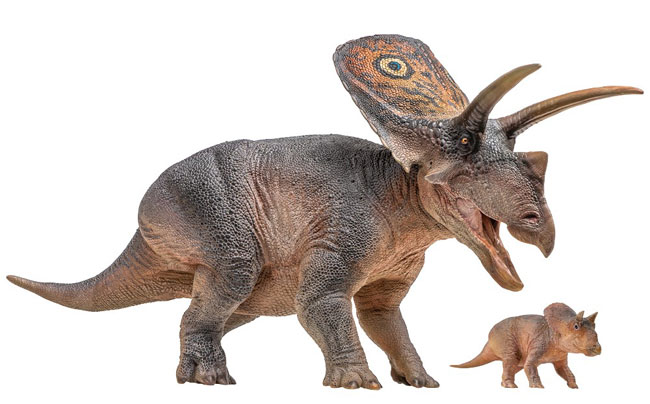
In horned dinosaurs, taxonomy is complicated by the fact that the cranial ornamentation that is often used to distinguish species changes radically with age. The long head shield of Torosaurus with its fenestrae was thought to represent the head crest of very old and mature Triceratops. New research using Canadian fossils refutes this theory and postulates that Torosaurus is a valid genus and the Canadian specimens mark the northernmost distribution of this ceratopsid.
The image (above) shows a replica of an adult Torosaurus with a juvenile. These figures are from the PNSO range of prehistoric animal figures.
To view the PNSO model range: PNSO Models.
Identifying Torosaurus
Torosaurus has been distinguished from the contemporary Triceratops by the presence of two large holes (paired fenestrae) in the neck frill, which tends to be longer and wider, formed by the longer and tapering squamosal skull bones. In addition, Torosaurus is associated with an increased number of epiparietals (bony bumps and horns) on the margins of the neck shield.
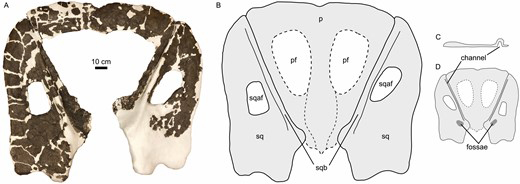
Parietosquomosal frill of Torosaurus latus (EM P16.1). Dorsal surface (A) which has been reconstructed using plaster and clay with interpretative drawing (B). Schematic transverse cross-section of squamosal near caudal edge based on a sketch by H. Jones. Schematic of frill showing paired fossae and channels on ventral surface of squamosals, based on sketch by H. Jones. Picture credit: Mallon et al.
Picture credit: Mallon et al
Osteohistological Sampling
A fragment of limb bone representing a portion of the left femur found in association with EM P16.1 was subjected to osteohistological analysis to determine the age of the dinosaur when it died. Small cross-sections of bone were cut and mounted onto epoxy resin. These were then carefully ground down to produce the extremely thin bone slices. Light microscopy and scanning electron microscopy (SEM) were then employed to reveal the bone structure at the cellular level.
Although the femur had been extensively repaired with plaster, enough of the bone structure remained for the research team to identify that this dinosaur was still growing when it died. They conclude that the fossil material comes from a late subadult or early adult individual and not an extremely old and mature animal. The scientists refute the hypothesis that Torosaurus represents very old examples of Triceratops.
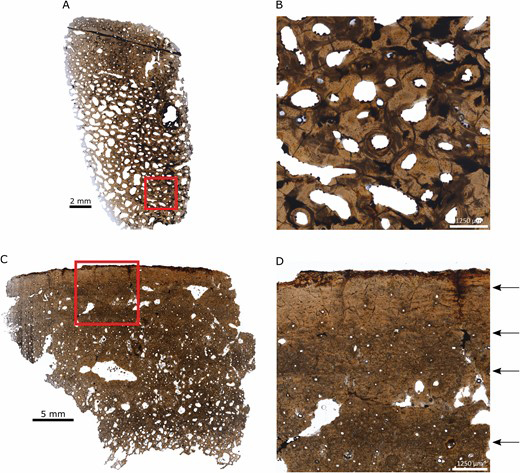
T. latus limb bones found in association with EM P16.1. Photograph (A) shows the thin cross-section of prepared bone taken from a fragmentary femur, the red box area is shown in greater magnification (B). Haversian tissue (C), thin section of cortical bone of left femur, the red box is highly magnifed (D). The bone analysis indicates that this individual was stil growing at the time of death, leading the researchers to conclude that Torosaurus is a valid genus and not simply a very old specimen of a Triceratops. Picture credit: Mallon et al.
Picture credit: Mallon et al
Torosaurus and Triceratops Present in the Late Cretaceous of Canada
Based on this study, the researchers conclude that Torosaurus was present in Canada during the Late Cretaceous. Triceratops is also known from fossils found in Canada, both the currently recognised species Triceratops horridus and the geologically younger T. prorsus have been reported. If the frill fossils and limb bone fragments do represent Torosaurus then they mark the northernmost range of this taxon.
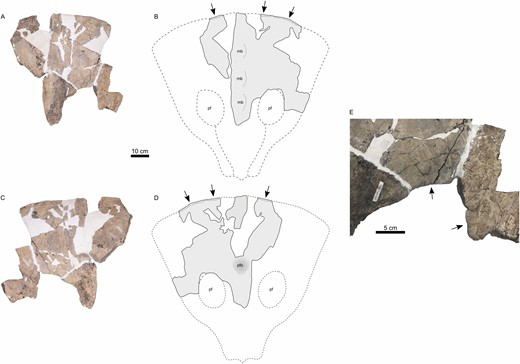
Parietal of Torosaurus latus (UALVP 1646). Dorsal surface (A); with (B) interpretive reconstruction of dorsal surface. The ventral surface is shown (C) and (D) interpretive reconstruction ventral surface. Photograph (E), detail of left parietal fenestra. Arrows in B and D indicate epiparietal loci. Picture credit: Mallon et al.
Picture credit: Mallon et al
Different Species of Torosaurus?
Intriguingly, much of the fossil material that was used in the original description of Torosaurus (Marsh 1891) was not precisely recorded. As a result, the stratigraphic distribution of the early collected Torosaurus fossils is unknown. Most of the recently collected Torosaurus latus fossils from the Hell Creek Formation comes from the lower half of the formation.
The majority of the Hell Creek Formation Torosaurus material was deposited earlier than the Torosaurus fossils from the geologically younger upper portion of the Scollard Formation and the Frenchman Formation of Canada which are approximately the same age as the uppermost parts of the Hell Creek Formation.
One Torosaurus specimen (MPM VP6841) is an exception it having been discovered in sediments associated with the upper part of the Hell Creek Formation. Specimen number MPM VP6841 compares closely to the Canadian specimen EM P16.1 and it has been proposed that these fossils may represent another Torosaurus species. The Hell Creek Formation was deposited over a period of at least 700,000 years (possibly as much as a million years).
Palaeontologists are aware that the Triceratops material associated with different stratigraphy represent different Triceratops species – T. horridus and the geologically younger T. prorsus plus another, as yet unnamed transitional form between the two.
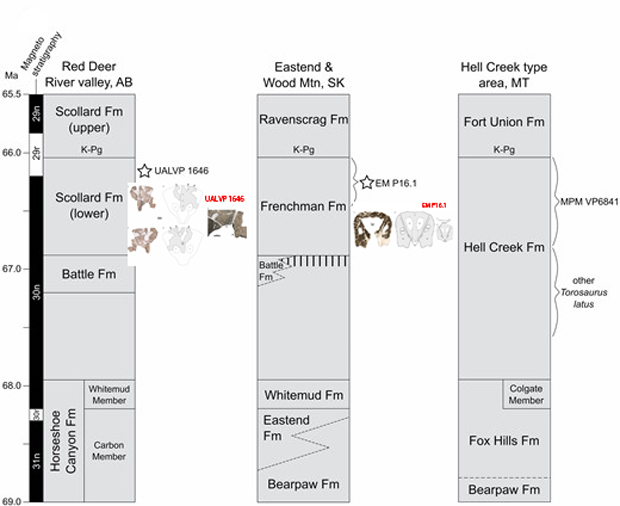
The distribution of Torosaurus latus fossil material suggests that as with Triceratops the Hell Creek strata may contain more than one species. Picture credit: Mallon et al with additional annotation by Everything Dinosaur.
Picture credit: Mallon et al with additional annotation by Everything Dinosaur
The researchers conclude that different species of Torosaurus would turn over in a similar manner as Triceratops within these uppermost Maastrichtian strata. There may be more species of Torosaurus identified in the future.
The scientific paper: “The record of Torosaurus (Ornithischia: Ceratopsidae) in Canada and its taxonomic implications” by Jordan C. Mallon, Robert B. Holmes, Emily L. Bamforth and Dirk Schumann published in the Zoological Journal of the Linnean Society.
The award-winning Everything Dinosaur website: Prehistoric Animal Models.

